| Eupomatia laurina | |
|---|---|
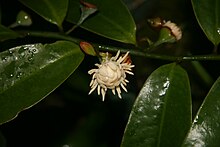
| |
| Bolwarra flowering in cultivation in Sydney | |
| Conservation status | |
 Least Concern (IUCN 3.1) | |
| Scientific classification | |
| Kingdom: | Plantae |
| Clade: | Tracheophytes |
| Clade: | Angiosperms |
| Clade: | Magnoliids |
| Order: | Magnoliales |
| Family: | Eupomatiaceae |
| Genus: | Eupomatia |
| Species: | E. laurina |
| Binomial name | |
| Eupomatia laurina R.Br. | |
Eupomatia laurina, commonly named bolwarra, native guava or copper laurel, is a species of plant in the primitive flowering-plant family Eupomatiaceae endemic to Australia and New Guinea.
Description
It grows to between 3 and 5 m (10 and 16 ft) tall, but larger specimens may attain a height of 15 m (50 ft) and a trunk diameter of 30 cm (12 in). It has glossy, ovate to elliptic leaves, from 5 to 20 cm (2 to 8 in) long. The branches bear globose to urn-shaped fruit which are green in colour and measure 15–20 mm (0.6–0.8 in) in diameter. They yellow when ripe and contain pale-coloured, edible, jelly-like flesh inside, with many non-edible seeds (similar appearance to guava contents).
Taxonomy
This species was first described by the Scottish botanist Robert Brown, based on material collected by himself and other crew members between 1801 and 1803, during the circumnavigation of Australia with Matthew Flinders in HMS Investigator. His work was published as appendix III of volume 2 of Flinders' book A Voyage to Terra Australis.
Brown created the new genus Eupomatia to accommodate this plant, and placed it in the family Annonaceae, but in 1845 the French botanist Charles Henry Dessalines d'Orbigny transferred it to the new family Eupomatiaceae.
Ecology
Flowers are pollinated by small weevils, including Elleschodes hamiltoni and others in the same genus.
Distribution and habitat
In Australia, it is found in humid forests of the east coast, from as far south as Nowa Nowa, Victoria, north through New South Wales and Queensland to Cape York Peninsula. In New Guinea, it is found throughout the island's eastern half (Papua New Guinea). It usually grows as an understory plant in rainforests or humid Eucalyptus forests.
Horticulture
In cultivation E. laurina is frost sensitive and prefers a protected, semi-shaded site. It can be propagated from seed or cuttings. Cutting propagated trees produce fruit after two years. Seedlings take four to six years to fruit. Cuttings are not advised as a method of regeneration. Germination from fresh seed commences after around three weeks and completes after five weeks, with a high rate of germination.
Gallery
-
 Foliage
Foliage
-
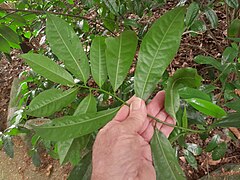 Foliage
Foliage
-
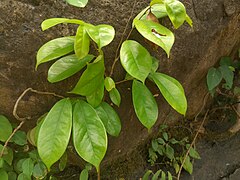 Juvenile plant
Juvenile plant
-
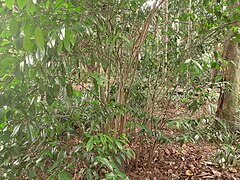 Habit
Habit
-
 Flower buds
Flower buds
-
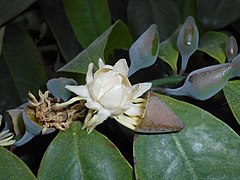 Operculum (the 'cap' of the flower bud) detaching
Operculum (the 'cap' of the flower bud) detaching
-
 Flower with weevils
Flower with weevils
-
With flowers and buds
-
 Fruit
Fruit
-
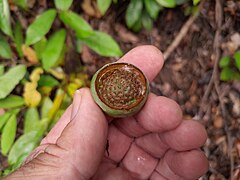 Fruit
Fruit
References
- Botanic Gardens Conservation International (BGCI); IUCN SSC Global Tree Specialist Group (2019). "Eupomatia laurina". IUCN Red List of Threatened Species. 2019: e.T144297071A149007808. doi:10.2305/IUCN.UK.2019-2.RLTS.T144297071A149007808.en. Retrieved 10 August 2024.
- "Eupomatia laurina". Australian Plant Name Index (APNI). Centre for Australian National Biodiversity Research, Australian Government. Retrieved 9 August 2024.
- "Eupomatia laurina R.Br". Plants of the World Online. Royal Botanic Gardens, Kew. 2024. Retrieved 10 August 2024.
- ^ Floyd, Alex G. (2008). Rainforest Trees of Mainland South-eastern Australia. Inkata Press. p. 156. ISBN 978-0-9589436-7-3.
- ^ F.A.Zich; B.P.M.Hyland; T.Whiffen; R.A.Kerrigan (2020). "Eupomatia laurina". Australian Tropical Rainforest Plants (RFK8). Centre for Australian National Biodiversity Research (CANBR), Australian Government. Retrieved 27 May 2021.
- ^ Cooper, Wendy; Cooper, William T. (June 2004). Fruits of the Australian Tropical Rainforest. Clifton Hill, Victoria, Australia: Nokomis Editions. p. 199. ISBN 978-0-9581742-1-3.
- ^ Brown, Robert (1814). "General remarks, geographical and systematical, on the botany of Terra Australis". A Voyage to Terra Australis. By Flinders, Matthew. Vol. 2, appendix III. London: G. & W. Nicol. pp. 597–598. Retrieved 10 August 2024.
- "Eupomatiaceae". International Plant Names Index (IPNI). Royal Botanic Gardens, Kew. 2024. Retrieved 10 August 2024.
External links
- View a map of collections and observations of this species at the Global Biodiversity Information Facility
- View observations of this species on iNaturalist
- See images of this species on Flickriver.com